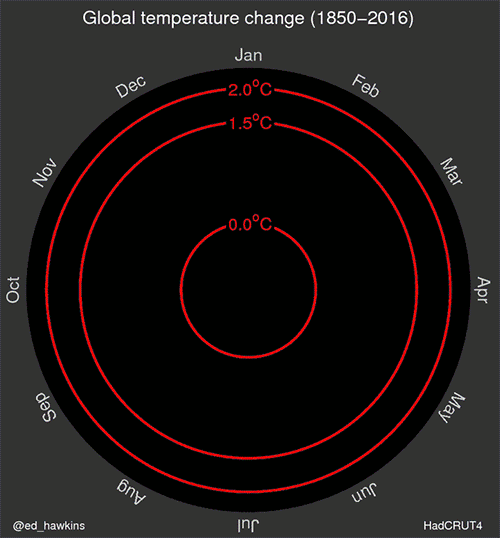
Ring of fire: spiralling global temperatures. Created by climate scientist Ed Hawkins of the University of Reading.
By Tushna Commissariat
As we face up to the realities of global warming and see the effects of climate change become apparent, it’s more important than ever that people the world over truly grasp its impact. With this in mind, University of Reading climate scientist Ed Hawkins has created the above animated spiral, which shows how the global temperature has changed over the past 166 years. Using data from the Met Office’s Hadley Centre observations datasets, Hawkins’ animation presents data in a a clear and artistic way. “The pace of change is immediately obvious, especially over the past few decades. The relationship between current global temperatures and the internationally discussed target limits are also clear without much complex interpretation needed,” says Hawkins, who is based at the university’s National Centre for Atmospheric Science. Take a look at his webpage to learn more about the project and for a list of specific weather events that are noticeable in the data.
Many families have long-running legacies that see many generations picking up a common profession and physicists are no different. Blood definitely runs thicker than water when it comes to families such as the Curies (who have won more Nobel prizes than any other family to date) or the Braggs (the only parent-child Nobel-prize-sharing duo), but there are a few more to add to the list. The Perimeter Institute’s Slice of Pi has compiled a list of people for whom “Physics runs the family”. While I had heard of most of them, I was rather surprised to find out that Wolfgang Pauli was Ernst Mach’s godson; or to see that three generations of the Bernoulli family were physicists or mathematicians – a grand total of eight scholars who laid the foundations of fluid dynamics, calculus and more.
Our regulars readers will recall, I am sure, a news story that we ran in January this year, about a “Maxwell’s demon” that operates without external control, which could be adopted as a nano-refrigerator. Created by physicists in Finland, the device cools a transistor as it separates electrons in terms of their energies and prevents the higher-energy electrons from reaching the transistor. The experiment was intriguing on many levels and raised some rather fundamental and philosophical questions about the nature of information and energy. Over on the Explanimator YouTube channel, there is an excellent video that links together the experiment with the idea of information and whether any information is “real” or not – do take a look at it.
If you feel like doing some fun science experiments with the kids this weekend, or if you fancy a lot of mac and cheese, take a look at Scientific American‘s Bring Science Home channel. You’ll find there a detailed experiment that uses mac and cheese to teach all about viscosity and the science of cooking, while also allowing you to get creative in the kitchen. Happy cooking!
Guidelines
Show/hide formatting guidelines
this text was deletedwhere people live in harmony with nature and animals</q>
Some text